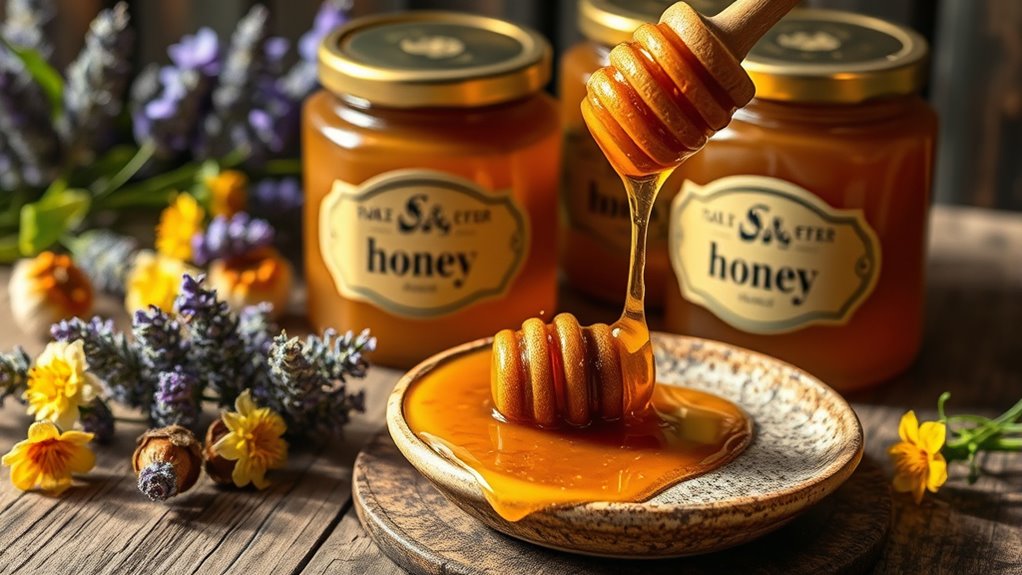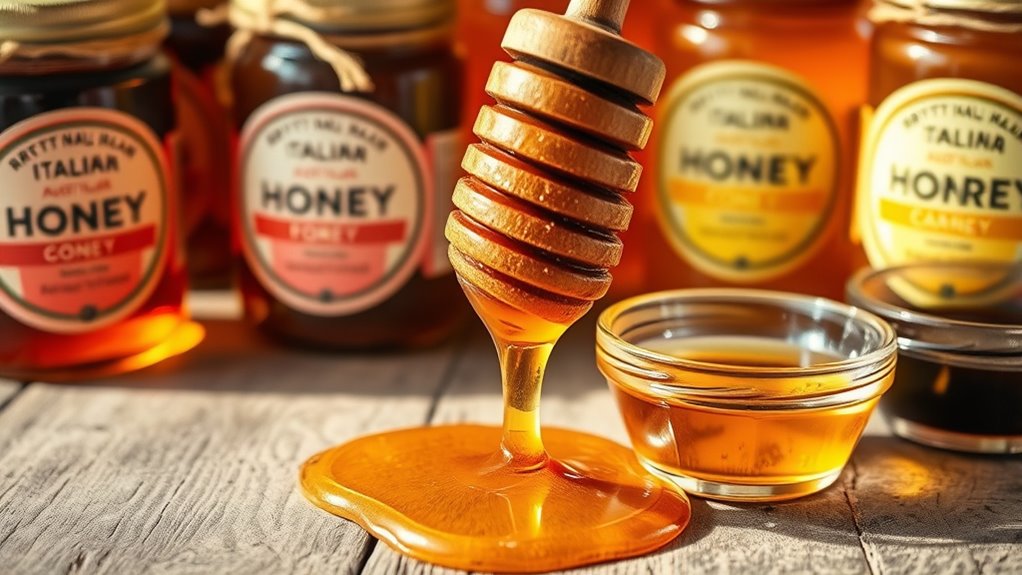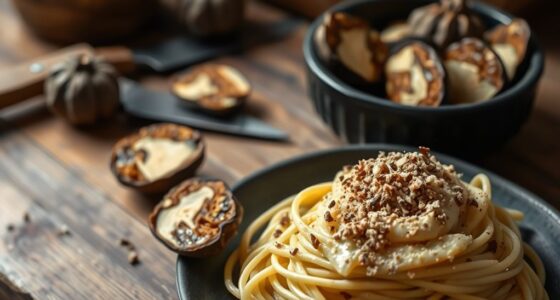Italy offers a rich variety of regional honeys, each with distinct flavor profiles shaped by local flora and climate. For example, Liguria’s honey is delicate and floral, while Tuscany’s is subtly fruity. Sicily provides aromatic citrus honey, and Sardinia offers dark, earthy heather honey. The unique environment and flowering plants create these regional differences, making each honey a reflection of its land. Explore further to discover how these natural influences craft Italy’s diverse honey flavors.
Key Takeaways
- Italy’s diverse regions produce unique honey flavors influenced by local flora and environmental conditions.
- Tuscany offers light, floral honey, while Sicily features richer, citrus-infused varieties.
- Liguria’s honey is delicate and aromatic, derived from wildflowers and herbs.
- Sardinia’s honey, like heather, is darker with a distinctive, aromatic profile.
- Harvesting practices and timing preserve regional flavors, supporting sustainable beekeeping and biodiversity.

Italy’s diverse landscapes and climates produce a rich variety of regional honeys, each with unique flavors and characteristics. As you explore these honeys, you’ll discover that their distinct profiles are shaped by the local flora and environmental conditions. From the rolling hills of Tuscany to the coastal plains of Sicily, every region offers a different taste experience that reflects its natural surroundings. Understanding honey harvesting is crucial to appreciating these differences. Beekeepers in Italy carefully time their harvests to preserve the honey’s quality, ensuring that each jar captures the essence of its specific region. This process involves not only collecting honey at just the right moment but also respecting the bees’ natural rhythms. Supporting bee conservation is essential here, as healthy bee populations are the backbone of honey production. By choosing local, sustainably harvested honey, you help promote the conservation of bees, which face threats from pesticides, habitat loss, and disease. Many Italian beekeepers adopt eco-friendly practices, such as providing wildflower forage and avoiding harmful chemicals, to sustain bee health and ensure a continuous supply of high-quality honey.
Additionally, attention and patience during the harvesting process can significantly impact the final flavor, as careful timing allows the honey to develop its full aromatic potential. As you sample different regional honeys, you’ll notice the wide spectrum of flavors. In Liguria, for instance, you might taste a delicate, floral honey derived from wildflowers and herbs, while in Umbria, a more robust, earthy honey from chestnut trees offers a richer profile. The honey from Sardinia’s heather blooms presents a darker, aromatic experience, perfect for spreading on bread or drizzling over cheese. Each variation tells a story of the land and the bees that gather nectar there. During honey harvesting, beekeepers often involve local communities, emphasizing sustainable practices that benefit both the environment and local economies. They take care to minimize disruption to bee colonies, recognizing that healthy bees are essential for ongoing honey production and pollination of regional crops.
Frequently Asked Questions
How Do Italian Honeys Vary Between Regions?
When you explore honey harvesting across Italy, you’ll notice regional honey varieties vary greatly. Different regions produce distinct flavors based on local flora, climate, and beekeeping traditions. You might find floral, fruity, or nutty notes depending on where the honey comes from. This diversity makes each honey unique, reflecting its regional origins. By sampling various regional honeys, you gain a richer appreciation for Italy’s diverse landscape and its influence on honey flavor profiles.
What Are the Health Benefits of Regional Italian Honeys?
You’ll find that regional Italian honeys offer notable health benefits thanks to their medicinal properties. Their unique flavors reflect local flora, which influences bee foraging habits and honey composition. These honeys can boost immunity, soothe sore throats, and provide antioxidants. By choosing regional varieties, you benefit from their natural healing qualities, as each honey’s medicinal properties are shaped by the specific plants bees visit in different Italian regions.
Which Italian Honey Pairs Best With Cheese?
You might think honey and cheese don’t mix, but pairing tips reveal otherwise. For a rich, creamy cheese like brie, try acacia honey; its delicate sweetness complements without overpowering. For sharper cheeses like pecorino, a robust honey such as chestnut enhances flavors beautifully. Trust your palate and experiment with different combinations to discover your perfect cheese pairing. The key is balancing sweetness and intensity for a memorable tasting experience.
How Should Italian Honey Be Stored to Maintain Quality?
To keep your Italian honey fresh, store it in airtight storage containers to prevent moisture and contamination. Avoid temperature fluctuations, as honey can crystallize over time; if crystallization occurs, gently warm the container to restore its liquid state. Keep it in a cool, dark place, away from sunlight, to preserve its flavor and quality. Proper storage guarantees your honey stays delicious and retains its natural consistency.
Are There Traditional Italian Honey-Based Recipes?
Imagine golden drops of nectar being carefully transformed into sweet masterpieces. You’ll find traditional Italian honey-based recipes that highlight local flavors, often inspired by honey harvesting and the unique bee species in each region. From drizzling over cheese to mixing into desserts, these recipes celebrate nature’s bounty. You’re invited to explore these time-honored traditions, where each spoonful tells a story of craftsmanship and regional pride.
Conclusion
Imagine tasting a drizzle of Acacia honey from Lombardy, its delicate sweetness dancing on your palate. By exploring Italy’s regional honeys, you discover a world of unique flavors that tell local stories. For instance, picture yourself spreading a spoonful of Zagara honey from Sicily on warm bread, savoring its floral notes. These regional varieties aren’t just sweet; they’re a journey through Italy’s diverse landscapes and traditions, waiting for you to discover them.









